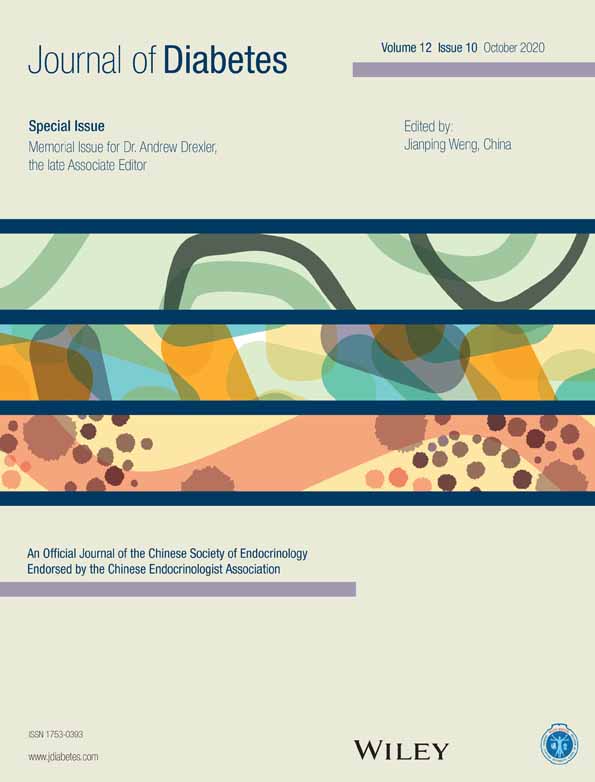Frequency, clinical characteristics, and determinants of partial remission in type 1 diabetes: Different patterns in children and adults
儿童及青少年与成人1型糖尿病患者蜜月期的发生率、临床特征及影响因素不同
Funding information: National Key R&D Program of China, Grant/Award Number: 2017YFC1309604; Science and Technology Major Project of Hunan Province, Grant/Award Number: 2017SK1020; Natural Science Foundation of Hunan Province, China, Grant/Award Number: 2019JJ40419; Natural Science Foundation of Hunan Province, Grant/Award Number: 2017YFC1309604
Abstract
enBackground
Partial remission (PR) is a special stage in type 1 diabetes (T1D). The different patterns of PR frequency, characteristics, and determinants in juvenile and adult patients are unclear, and data on Chinese are lacking.
Methods
A total of 186 children and 114 adults with T1D who were regularly followed up in a cohort were included for analysis. PR was defined according to C-peptide ≥300 pmol/L or index of insulin dose-adjusted hemoglobin A1c ≤9, as previously recommended. C-peptide and islet autoantibodies were determined with chemiluminescence and radioimmunoassay, respectively.
Results
The frequency of PR in children was higher than that in adults, with the proportion being 69.9% and 58.8%, respectively (P < .05). For juvenile-onset T1D, the frequency of PR gradually decreased as the onset age decreased, from 87.5% in 13- to 18-year olds to 46.5% in under 6-year olds. Multivariable analyses showed that onset age and male sex were positively related with the frequency of PR in children, while the related factors in adults were initial glycosylated hemoglobin A1c and C-peptide levels. The median PR duration was similar in children (14.8 ± 1.2 months) and adults (16.4 ± 1.9 months). Older onset age was related with a longer PR duration in children, but no such associations were found in adult individuals.
Conclusions
Children and adults with T1D have different patterns on PR frequency, clinical characteristics, and determinants. For patients during this special phase, the relatively high C-peptide level and to reduce insulin dosage accordingly should be emphasized in clinical practice.
摘要
zh背景
蜜月期(partial remission, PR)是1型糖尿病(type 1 diabetes, T1D)病程中胰岛功能短暂恢复的特殊时期。PR的发生率、临床特征及影响因素等尚缺乏中国人群的研究数据, 且儿童及青少年患者与成人患者间PR发生情况的差异尚未明确。
方法
本研究从一个自身免疫性糖尿病随访队列中, 共纳入186名儿童及青少年T1D患者及114名成人T1D患者。PR的定义为:1)C-肽≥300pmol/L; 或2)胰岛素校正糖化血红蛋白指数≤9。采用化学发光法检测C-肽, 采用国际标准放射配体法检测胰岛自身抗体。
结果
与成人患者相比, 儿童及青少年患者PR的发生率较高(69.9% 对 58.8%, P<0.05); 在儿童及青少年患者中, PR 的发生率随起病年龄减少而减少, 从13~18 岁儿童的 87.5%, 到小于 6 岁儿童的 46.5%。多因素分析结果表明:在儿童及青少年患者中, 起病年龄及男性性别与PR的发生率呈正相关; 而在成人患者中, PR的影响因素有起病时HbA1c及C-肽水平。儿童及青少年患者与成人患者PR的持续时间相似, 分别为(14.8±1.2)月和(16.4±1.9)月; 在儿童及青少年患者中, 起病年龄越大则PR持续时间越长, 而在成年患者中却未观察到此现象。
结论
儿童及青少年与成人T1D患者间, PR的发生率、临床特征及影响因素等均有差异。在临床工作中, 应关注到T1D患者的PR状态其C-肽水平变化, 及时调整胰岛素方案。




